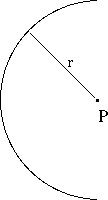
|
|
So far we have concentrated on calculating the electric potential first, and then obtaining the electric field. Are there any cases where it is easier to obtain the electric field directly?

The figure above shows a semicircular arc of radius R, with point P at its center. A total charge Q is uniformly distributed over this arc.
a: What is the potential V at point P?
b: Can you find the electric field at P by using the potential V obtained in a and taking its gradient? If you can, what is the answer? If not, why not?
|
|
Once you're done, click here to learn how to deal with two equal point charges.

